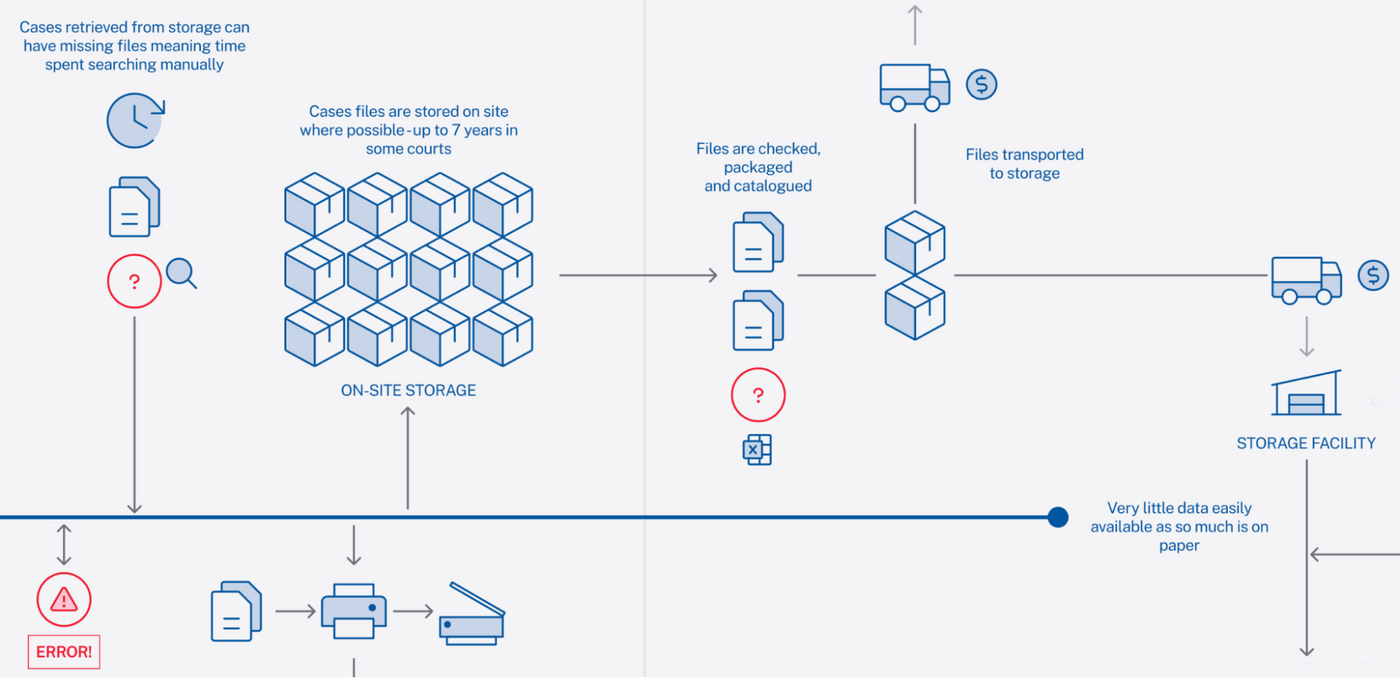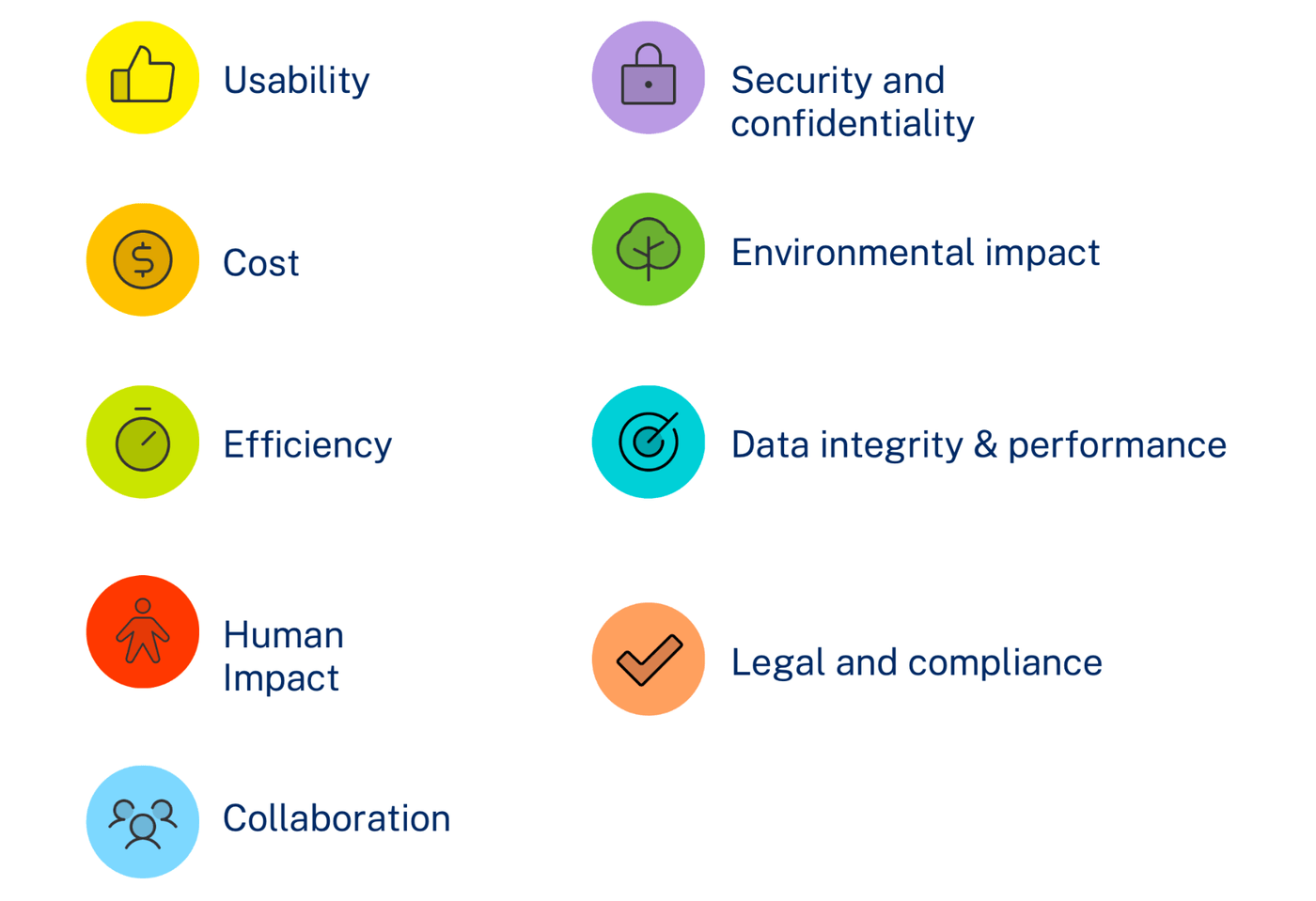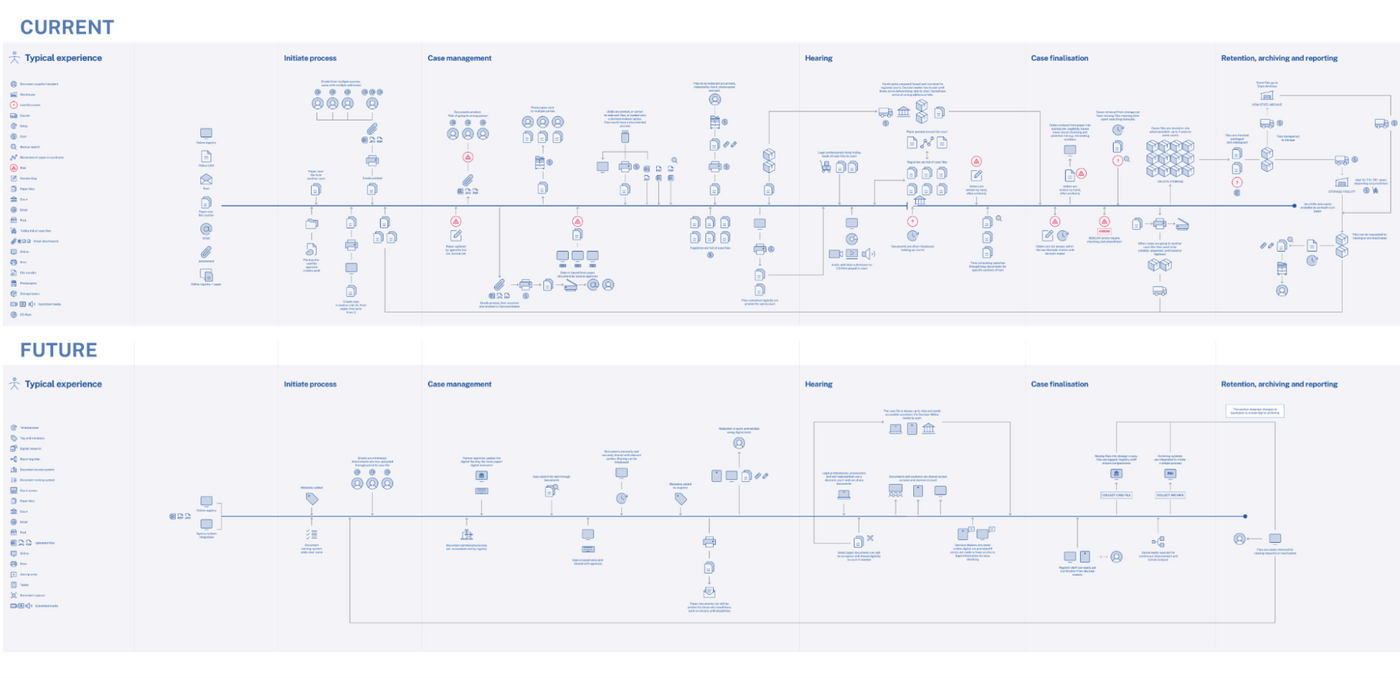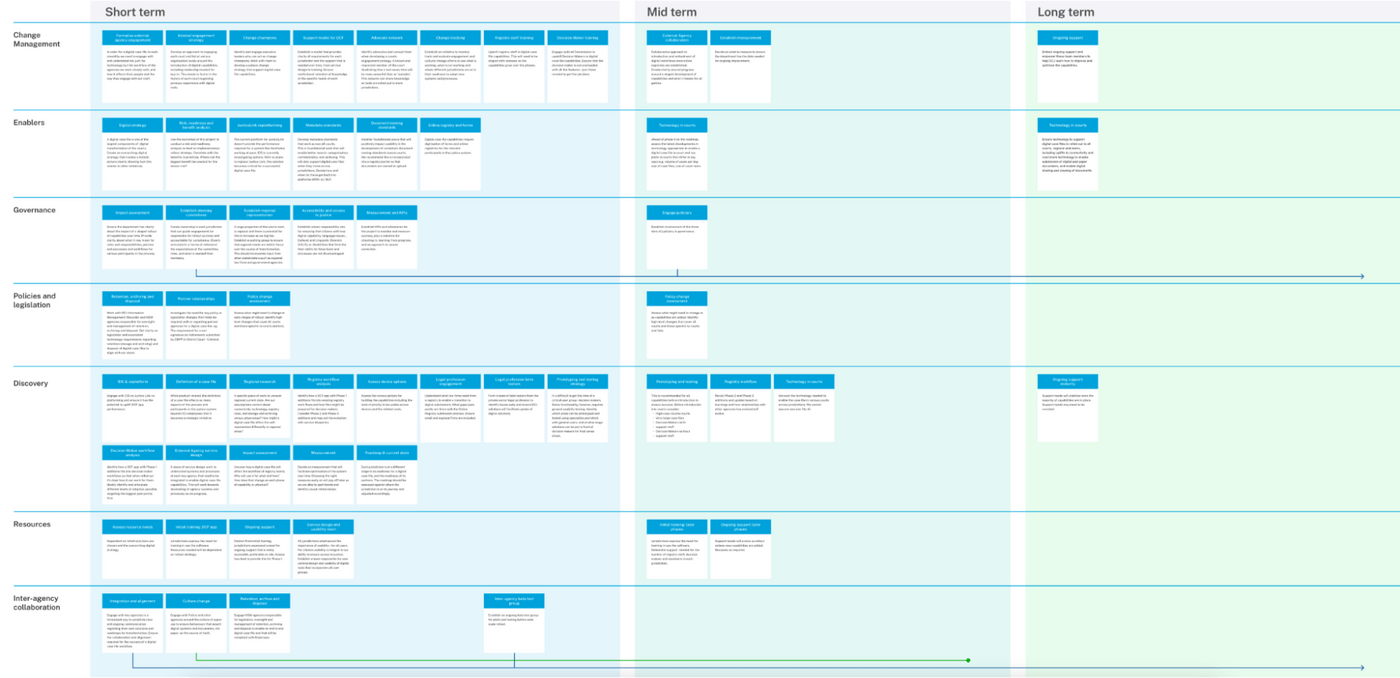The Department of Community and Justice (the Department) is responsible for the operation of courts and tribunals across New South Wales. Central to a court case, whether civil or criminal, is what’s commonly known as a case file. This is a collection of documents such as charges, appearance dates, court orders and evidence. The case file accompanies the life cycle of the case, and in some cases is needed again many years later. Like other jurisdictions around the world, the use of paper in managing case files is entrenched – and highly inefficient. The burden of paper case files will only intensify with a steadily increasing caseload.
The Department intends to digitally transform case files in all jurisdictions, end to end. This will empower the judiciary and court staff with easier ways of working that are impossible with paper.
Previous initiatives to digitalise had become fragmented and not all of them had delivered the intended impact. The Department wanted to better understand why and to build a clear, realistic pathway to a more efficient future.

The Opportunity
The courts and tribunals of NSW are a complex system of ten jurisdictions that cover civil and criminal matters, from the smallest to the largest in scale and impact. This includes everything from petty theft to systematic fraud, unpaid bills, property and land disputes, unexplained deaths, guardianship and child protection, libel, violence, workplace and union disputes, dust disease compensation, inequality and drug rehabilitation.
The needs of each jurisdiction vary, as does the terminology and the legislation they navigate. Each has different dependencies, different stakeholders, different ways of working with a case file, and even different requirements for what happens to that case file once the case is closed. The case file itself ranges from just a few pages to hundreds of boxes of paper.
The system as a whole has a duty to ensure access to justice for all its citizens, and must preserve the independence of the judiciary. This last factor means that unlike most organisations the Department cannot mandate ways of working or the software used by anyone except registry staff.
Within this complexity, the Department needed to gain a high level view across all courts and tribunals. They wanted to:
- Build a picture of the current state of case file digital transformation
- Assess and articulate the need for change
- Understand the capabilities still needed in order to reach an end-to-end digital case file workflow
- Understand the human and organisational factors that will contribute to the success of digital transformation
The objectives were to:
- Identify the problems an end to end digital case file can solve and the benefits it will bring
- Map the current state illustrating gaps and pain points
- Map the desired future state
- Create a product roadmap showing how the Department could reach the future state
- Create a strategic roadmap of initiatives needed to support the journey of change
This work was not intended to specify solutions, but to articulate the problems and how they might be solved. The overall goal was to align stakeholders and support a business case for funding.

Our Approach
We took a human centred, service design approach to understand not only the digital and technology gaps but the human factors critical to the successful uptake of digital case file tools.
In a complex space with so many challenges and high level outputs, we knew we’d need to understand a lot of detail yet retain the discipline to focus at the right level. The project would require a number of zoom levels of design practice, from a systems design understanding to the impact of UX/UI design on adoption of tools.
Due to the timeline we needed to quickly identify areas of enquiry and mitigate the risks of not being able to engage with every stakeholder group. We had the benefit of a team of highly knowledgeable Department SMEs who had worked on digital initiatives and were familiar with various courts and the way they work.
1. Desktop Research
The Department was keen for us to take on board previous work, learn from it and build on it. This included everything from previous persona work by the Department to researching approaches to digital case files around the world.
Early on we identified the importance of usability, plus access and accessibility for all participants in the system. We began developing design principles to guide future work. We also identified areas for enquiry in our stakeholder research - what did we need to learn?
2. Vision
We co-created a vision for a digital case file with the team to capture the needs and aspirations of the Department. This consisted of both a vision statement and an unpacking of that vision so that we could create alignment. This was then validated and iterated during stakeholder research.
We also used the more detailed vision to help identify what the jurisdictions prioritised.
3. Stakeholder Research
Adding to individual and team engagements our main opportunity for gaining a deeper understanding was through stakeholder workshops. With a limited time we needed to use the workshops efficiently.
We used several tools and techniques in order to understand:
- Their current state of digital transformation
- Where digital initiatives had been successful and if they hadn’t – why?
- Potential barriers and risks to mitigate
- How they interacted with partner agencies and the nature of any challenges
- What constituted a case file, where its contents com from, and how the judiciary work with it currently
- The needs and pain points of registry staff
- Their level of alignment with vision we had developed
- Their priorities for a digital case file
4. Current and Future-State Maps
Before stakeholder workshops we had created a structure for a current state map which we populated with our understanding of each court’s current status – including new initiatives being launched during our research period – and known pain points. We were able to identify and validate patterns of common issues as well as differences.
We ensured that the current state map captured the very beginning of a case file through to retention, archiving or disposal.
With the future state map we answered the questions:
- What might the journey of a case file look like when we have all the capabilities we need to enable a digital case file?
- What might the benefits be for registry staff, judiciary, partner agencies, the legal profession, citizens and other stakeholders?
- What might the impact be on cost, flexibility of work, and use of time?

5. Capability Roadmap
Early on we stopped talking about a ‘product roadmap’. This was to move away from the unrealistic and risky perception that one monolithic software would provide all the features needed. Instead we identified the capabilities software would need to enable end to end digital case files and the foundations - or enablers - that would make software effective across all the courts.
We included in-flight initiatives and areas in which a current tool needs to be uplifted in order to gain traction. We showed how adding the right metadata and consistent naming when documents are uploaded would not only help search and document identification, it would support the movement of case files between jurisdictions and make archiving efficient.
We also built the roadmap with human impact in mind: if the judiciary doesn't find the tools usable or useful enough, the whole project is at risk. What would they find most useful, and what needs to be put in place to solve their most painful problems first?
Critically, we also included areas for discovery work and identified opportunities to work ahead to set up the next phase.
6. Strategic Roadmap
In order to support the Department in its planning we developed a roadmap showing the initiatives needed to support the success of a future digital case file.
The sequencing was aligned with the Capability Roadmap;
- What needs to be done first?
- What could the Department get started on without funding?
- How and when should it engage with partner agencies?
- Where are the gaps in our knowledge and what discovery work needs to be done?
- Where does the Department need to look at changes in policy and legislation?
- What resources can they expect to need?
- What change management programs might be required?
Again, this was at a high enough level to shape the path forward without specifying software or other individual solutions.

7. Final Report
Giving the maps context and depth, we created a report that articulated the process, fleshed out the findings and identified actions the Department can take. We detailed and categorised both the problems caused by the current state – a simple example being the time taken to search for specific text through a paper document compared to digital – and the benefits of the future state once the capabilities are in place.
The report also included elements to guide and support change, such as design principles, and an appendix with more of the detail uncovered during research. This was included to ensure the report captured as many research outcomes as possible so that it could act as a reference point far into the future.
Outcomes
- For the first time, the Department has an understanding of the differences and similarities between the courts and tribunals.
- The Department has a clear idea of the foundational initiatives and software capabilities needed to facilitate efficient digital case files across all jurisdictions
- The approach we took means that human impacts are considered first, ensuring that the technology will be in service of people, and not the other way round.
- The Department also has a detailed view of the problem spaces and a pathway forward that has been validated with each jurisdiction, facilitating further feedback and buy-in. It is clear each jurisdiction has been listened to and they each will see themselves and their challenges articulated in the report.
- The maps and report directly feed the business case the Department is submitting to gain funding for the work from NSW Treasury
- Before funding arrives the Department has a clear indication of where it can start on pre-work
- The Department has clear direction in what it can measure to indicate the success of the project
Team
- Sophie Turner, Strategic Design
- Simon Goodrich, Account Management
- Alex Crowfoot, Strategic Design
- Louise Williamson, Consultant